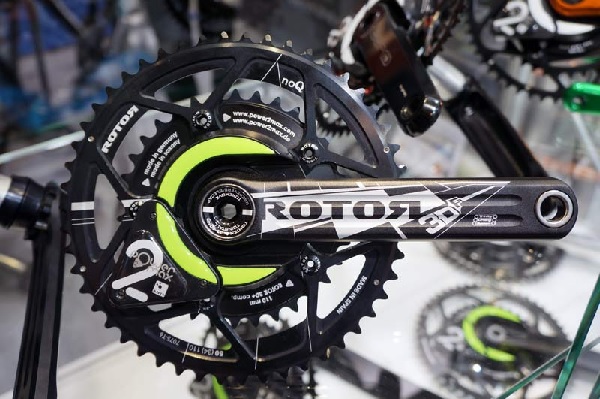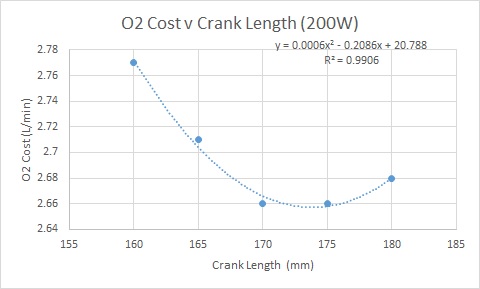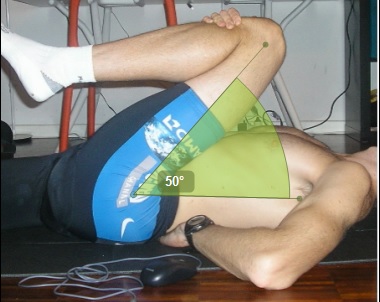Forget the disc wheel: Your most important 'upgrade' is the right crank!
Alan Couzens, MS (Sports Science)
Sept 3rd, 2014

I recently wrote a couple of articles on how bike geometry interacts with body geometry – specifically how your open hip angle impacts the stack and reach of your optimal bike frame. The one big factor that I left out of that equation that can have a VERY large impact on both comfort and efficiency is crank length.
Crank length is a sort of 'linch pin' in bike fit. An often ignored factor where fairly small errors can have quite large effects & an otherwise good fit can turn into a very bad one, especially if you happen to be unfortunate enough to require a smaller frame size (which will almost certainly come with a comically disproportionate crank length!).
A crank length that is too long for the athlete’s hip mobility will result in a number of compensations that, at worst lead to injury, and at best lead to high levels of discomfort during longer rides. When the crank is too long, we will see the low back excessively rounded and the hips rocking from side to side. Often the athlete will complain of hip flexor tightness. We may also see subtle but important compensations at the foot and tibia, where the athlete will internally or externally rotate in an effort to effectively 'shorten the foot' to accommodate the excessive crank length.
If the biomechanical implications don't scare you, a crank length that is on the long side will also prevent an athlete from rolling the hips forward into an effective aero position and will actually cost them a not insignificant amount of speed!
On the flipside, a crank length that is too short (a less common problem) will result in a loss in economy as the athlete is not taking the prime mover muscles through their full range of motion. Muscles are most efficient when they fully contract from their maximal resting length. Contracting from an already shortened position is less efficient. Period. Need more proof? If an individual had ongoing access to a metabolic cart and an ergometer with a vari-crank installed, and if he were so inclined, he could test the economy differences for a given crank length at a fixed wattage of say 200W over successive days. The results from those trials are below :-)

The chart shows a definitive 'sweet spot' of lowest O2 cost for a given crank length for me in the 172.5-175mm range (not coincidentally, I switched my own cranks to 172.5 on this basis). However, this is not to say that 172.5 or even a similar relative percentage of leg length is optimal for all. I have performed a similar experiment on another athlete (an elite cyclist) with quite different results. No, in my opinion, the optimal crank length is far more related to your personal hip mobility. More specifically, to keeping the pedal cycle within the optimal range of the prime mover muscles designed for the task(!) It is most determined by mobility in one key movement – hip flexion. You can assess your own via this simple test.

Lay on the floor with both legs extended & your hand placed underneath your lumbar spine to feel for any 'rounding'. Raise one knee up towards your chest and stop at the point where you notice either the knee start to drift to the side or the low back start to round out. You want to identify the angle of maximal hip flexion before any compensation creeps in. Get a spot check of the angle at this point and then make certain that you don’t exceed this angle when the hips are maximally 'closed' on the bike.
The best method of finding the right crank length for the job is via trial and error with video from the side and front taken for each crank trial. You can then look at this video and compare your closed hip angle with the uncompensated angle that you achieved in the test.
In practice, this can be a bit of a challenge because…
- a) You need the technical expertise to be able to switch out the cranks.
- b) You need a cooperative bike shop who will let you ‘try on’ some different options
- c) You need crank manufacturers to step up to the plate and start offering more options, especially if you’re a shorter or less flexible athlete. A great post on that topic here from Greg Kopecky with some info on manufacturer options for different lengths. This is even more the case if you're looking for a crank based power meter (as I'm sure you all are :-). The Rotor cranks shown on the Power2Max above are a versatile crank that span the gamut of crank length options (and look bad-ass :-). I use them on my own TT bike & would recommend them.
To help you narrow down your crank trials, I’ve prepared the following calculator.
Plug in….
| Open hip angle (as described in last test) | |
| Closed hip angle (as described above) | |
| Seat angle – from bottom bracket to where you actually sit on the seat. | |
| Seat height – distance along that line (in cm) | |
| Femur length – Greater trochanter to knee line (cm) | |
| Virtual tib length – diagonal distance from knee line to bottom of your cleat (cm). | |
| Crank length: |
It will spit out a suggested crank length rounded to the nearest 2.5mm designed to put you in a bike position that will replicate the closed hip angle given above.
If possible, I would suggest trialing cranks 5mm either side of this number and assessing your angles as described above.
You’ll see small changes in any number of variables on the calculator can have a large impact on recommended crank length. For instance…
Changes in that closed hip angle that span a very normal range of 50-60 degrees can lead to +/-10-15mm in recommended crank length! This fact alone leads to the majority of AG athletes being on the wrong crank.
You’ll also notice that the more forward the athlete is able to rotate their position, the more latitude they have with their crank selection. This presents an additional problem for many AG athletes who have a hard time rotating their hips forward and ride at a substantially shallower seat angle to the pros. This exacerbates the issue of Johnny Deskworker trying to replicate his favorite position of Torbjorn!
These realities of modern tri are simply not well accommodated in ‘off the shelf’ specs. Your average recreational cyclist just doesn’t have the same hip mobility of the competitive cyclists on whom those initial frame size vs crank length ratios were based. Therefore, it is essential to your long term comfort and economy that you 'take things into your own hands' to find the right crank length for you.
This is not to say that most athletes can't 'learn to live with' a variety of crank lengths but rather to say that the vast majority of recreational cyclists that I see are riding around with some level of dysfunction and uneconomical movement compensations that are costing them comfort, costing them watts, costing them speed & are often very easily fix-able with a few cheap 'custom upgrades'
In summary, pulling all of the recent bike fit articles together, when looking for a new ride (or upgrading your old one)….
- Buy a frame with the right stack and reach for your dimensions and true mobility.
- Ensure that you have sufficient steerer tube length and the right stem/bar set up to get you to an appropriate pad stack
- Tell your friendly bike sales guy that you’ll also need a crank switch out for the price of ‘free’ :-) and that you’ll want to trial your options.
- Find the right saddle that will allow you to rotate your hips forward (also for the price of free or at worst case – a discount).
Many folks feel pressured when buying a new bike. There’s a feeling that any extra time that the bike shop guy puts into fitting you, he’s ‘doing you a favor’. Trust me, most bike shop owners don’t have the background in biomechanics to give you a worthwhile fit (nor do most fitters for that matter!), let alone a good 15 minute fit, and you will be far better served by the ‘favor’ of a generous ‘try before you buy’ or return policy.
Buy smart,
AC.
TweetDon't miss a post! Sign up for my mailing list to get notified of all new content....
